Teodorescu P.P. Mechanical Systems, Volume III: Analytical Mechanics
Подождите немного. Документ загружается.

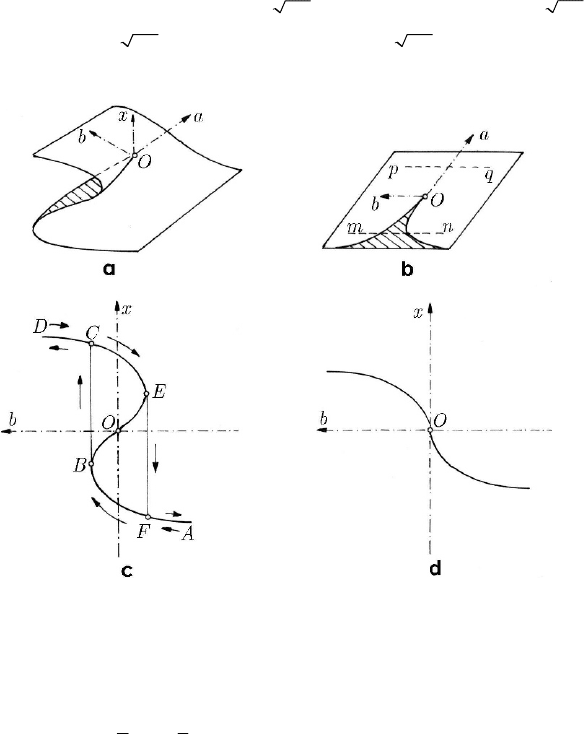
MECHANICAL SYSTEMS, CLASSICAL MODELS
692
2
0, 2 0xa x+= =.
(24.2.13'')
The first equation represents a parabola in the phase space, for
< 0a (Fig. 24.26a); by
eliminating the variable
x , we obtain = 0a in the control space (Fig. 24.26b). In
conclusion, for
> 0a we have no position of equilibrium, for < 0a we have two
positions of equilibrium: one stable
=−xa (for which
=−>
22
d/d 2 0Vx a
)
and one instable
=− −xa(for which =− − <
22
d/d 2 0Vx a ), while for = 0a
we have a double root
= 0x , to which corresponds a cuspidal point.
Fig. 24.27 Representation of the potential of a cusp in the control space: the surface S (a); the
semi-cubical parabola (b); section by a plane
consta = ; 0a < (c); 0a > (d)
An elementary catastrophe of fourth degree is the cusp of potential
=+ + =
42
11
() , , const
42
Vx x ax bxab
;
(24.2.14)
its derivatives allow to write the equations
++= +=
32
0, 3 0xaxb xa .
(24.2.14')
The first equation leads, in the phase space, to the surface
S in Fig. 24.27a. By
eliminating the variable
x between the equations (24.2.14'), we obtain the equation
+=
32
4270ab,
(24.2.14'')
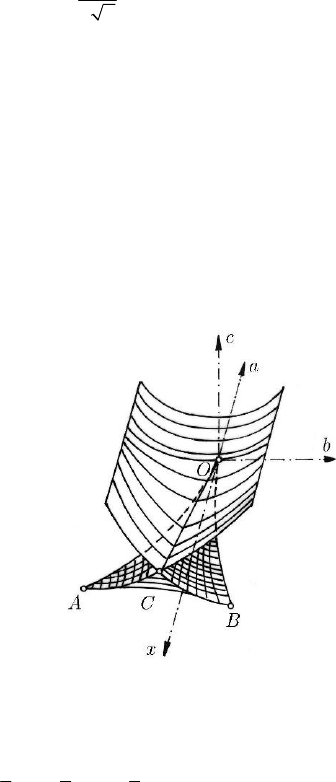
Dynamical Systems. Catastrophes and Chaos
693
corresponding to a semi-cubical parabola (the cusp)
3/2
2
(), 0
33
baa=± − <
,
(24.2.14''')
symmetric with respect to the
Oa -axis (Fig. 24.27b). If the point (,)ab belongs to the
hatched domain, then the first equation (24.2.14') has three real roots, while if it is
outside that zone, then it has only one real root; finally, if the point
(,)ab is on the
cusp, then the equation has all the roots real (one simple and one double).
A section by a plane
const, 0aa=<, parallel the plane to Oxb , pierces the
surface
S along the curve in Fig.24.27c; hence, the trace of the plane Oab is mn . If
we start from
A and b is increasing, one travels through the path ABCD , having a
jump
BC ; starting from D , with b decreasing, the path DEFA with the jump EF is
travelled through. Hence, the branch
BOE is instable. If > 0a , then the trace on the
plane
Oab is pq , the intersection with the surface S being the curve in Fig.24.27d.
Fig. 24.28 Representation of the potential of a swallow tail in the control space
The potential of fifth degree
=+ + + =
532
11 1
() , ,, const
53 2
Vx x ax bx cxabc
,
(24.2.15)
corresponds to the elementary catastrophe called swallow tail. The equations
+++= ++=
42 3
0, 4 2 0aaxbxc x axb
(24.2.15')
put in evidence the position of equilibrium and the critical points, respectively. By
eliminating the variable
x , one obtains a relation of the form =(,,) 0fabc . which
represents a surface
S in the control space. To make a study of this surface, we
calculate
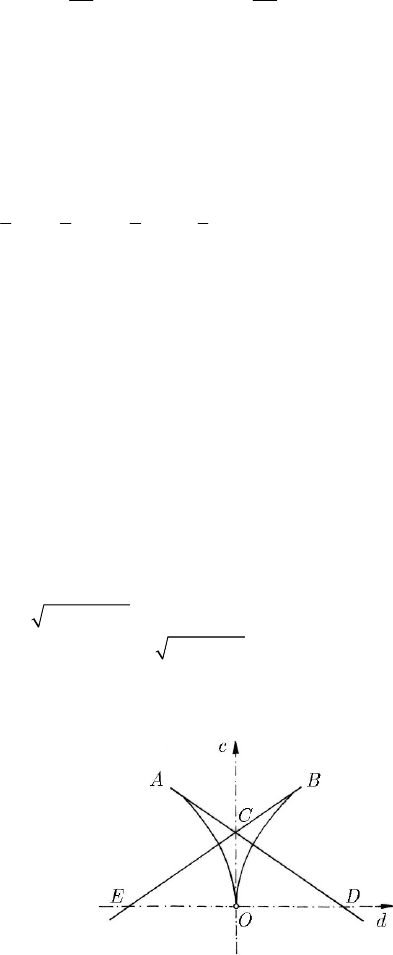
MECHANICAL SYSTEMS, CLASSICAL MODELS
694
()
=− + = +
23
ddc
12 2 , 12 2
dd
b
xa xax
xx
,
wherefrom
=−d/dcb x. One obtains the representation in Fig. 24.28 of the surface
S , which has four critical points: the point of maximum O , the cuspidal points A and
B and the point of self-intersection C ; the name given to this elementary catastrophe
is justified by the form of the cross section for
< 0a .
The potential of sixth degree
=+ + + + =
6432
11 1 1
() , ,,, const
64 3 2
Vx x ax bx cx dxabcd
,
(24.2.16)
corresponds to the elementary catastrophe called butterfly. One obtains the equations
532 4 2
0, 5 3 2 0x ax bx cxd x ax bxc++++= + ++=;
(24.2.16')
in this case, the phase space is five-dimensional, while the control space is
four-dimensional. To can make a study of the hypersurface
=(,,,) 0f abcd in the
control space, we start from
=− − − = + +
42 532
() 5 3 2 , () 4 2cx x ax bx dx x ax bx .
For instance, for
= 0b and for the butterfly factor < 0a , one obtains the
representation in Fig. 24.29, which justifies the denomination of butterfly given to this
elementary catastrophe. The points
A and
B
have the co-ordinates =
2
(9/20)ca and
=−
2
(6/25) (3/10)daa∓
, respectively, the points D and E have the co-ordinates
= 0c and =± −
2
(6/25) (3/5)daa, respectively, while the point of
self-intersection
C has the co-ordinates =
2
(1/4)ca and = 0d . Obviously, one can
build up also other curves, corresponding to other values of
a and b .
Fig. 24.29 Representation of the potential of a butterfly in the
control space for 0b = and 0a <
One can consider also potentials of higher degree, but which are less useful in
practical applications.
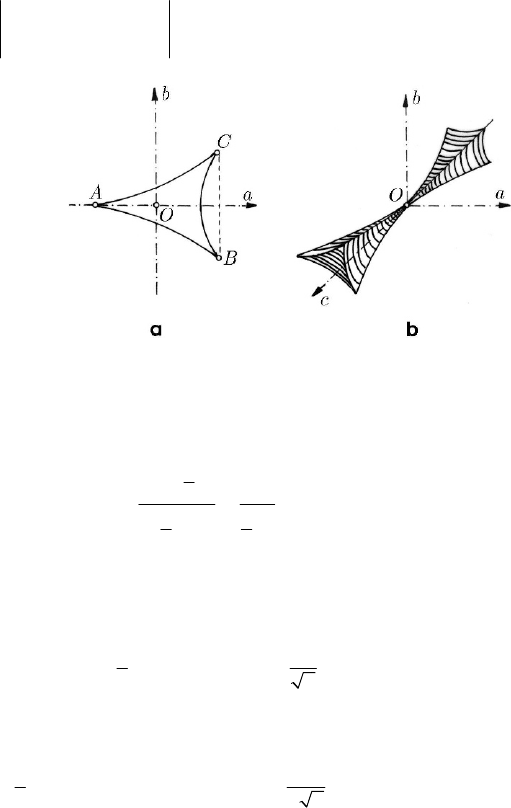
Dynamical Systems. Catastrophes and Chaos
695
24.2.2.3 Elementary Catastrophes in Two Variables
The most important elementary catastrophe in two variables is the umbilic. Thus, the
potential
()
=− +++ + =
32 22
(,) , ,, constVxy x xy ax by cx y abc
(24.2.17)
leads to the elliptic umbilic. The phase space and the critical points are given by the
equations
()
−++ =− ++ =
+−
=− + − − =
−−+
22
22 2
320,220,
62 2
43 2 0.
222
xyacx xybcy
xc y
xy cxc
yxc
(24.2.17')
Fig. 24.30 Representation of the potential of an elliptic umbilic in the
control space (a); a section
constc = (b)
We notice that the last of these equations can be written also in the form
()
−
+=
2
2
22
3
1
44
93
c
x
y
cc
,
(24.2.18)
the denomination of this elementary catastrophe being thus justified.
We can use the parametric representation
=+ =
12
(1 2 cos ), sin
3
3
xc y cθθ;
(24.2.18')
the first two equations (24.2.17') lead then to
=− + + = −
22
14
(3 8 cos 4 cos 2 ), (sin 2 2 sin )
3
33
ac b cθθ θθ
.
(24.2.18'')
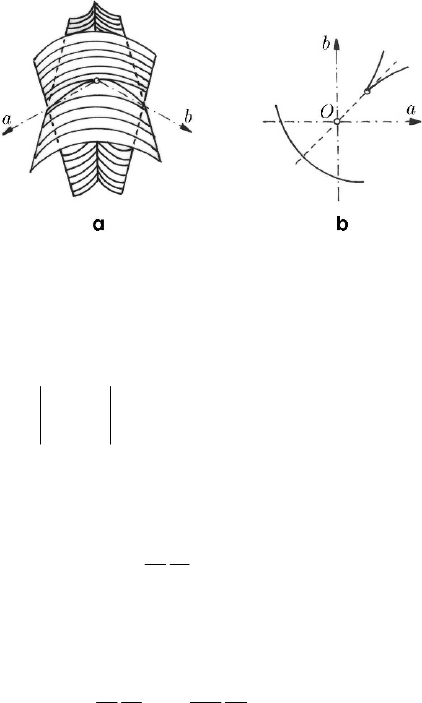
MECHANICAL SYSTEMS, CLASSICAL MODELS
696
The surface is reduced to the point
==0ab for = 0c . The sections made in the
surface
=(,,) 0fabc by the plane = constc have three cuspidal points for = 0θ
and
=±2/3θπ; to these values of the parameter θ correspond the points
−−
222
(5 ,0), ( ,2 )Aa Bc c and
22
(,2)Cc c . The plane Oab is a plane of symmetry for
the surface in the control space, because the co-ordinates of these points remain the
same if one replaces
c by −c . This surface is drawn in Fig. 24.30a, while in
Fig. 24.30b is drawn a section
= constc in it.
The hyperbolic umbilic has the potential
=+−−+ =
33
(,) , ,, constVxy x y ax by cxyabc .
(24.2.19)
Fig. 24.31 Representation of the potential of an hyperbolic umbilic in the
control space (a); a section
constc = (b)
The equations
22
2
30,30,
6
36 0
6
xaxcy ybcx
xc
xy c
cy
−+= −+=
=−=
(24.2.19')
specify the five-dimensional phase space and the critical points; the control space
S
is
three-dimensional. The last of these equations can be written in thus form
=
2
1
36
c
y
x
(24.2. 20)
too, which justifies the name given to this elementary catastrophe; choosing
x as a
parameter, we also find
=+ = +
34
2
2
11
3,
36 432
cc
ax b cx
x
x
.
(24.2.20')
Proceeding analogously, we make sections by planes
= constc . If = 0c , then
==0ab ; hence, the axes Oa and Ob belong to this surface. In Fig. 24.31a one
presents the surface
S , while in Fig. 24.31b is given a section by a plane = constc .
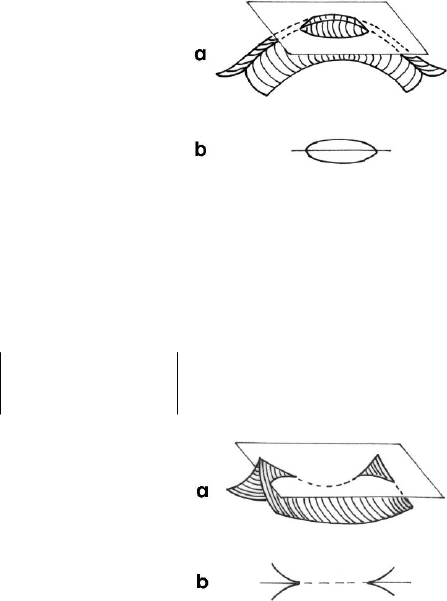
Dynamical Systems. Catastrophes and Chaos
697
The potential
=+ +++ + =
42 2 2
(,) , ,,, constV x y y x y ax by cx dy a b c d ,
(24.2.21)
Fig. 24.32 Representation of the potential of a parabolic umbilic in the
control space: lips (a); plane sections (b)
corresponds to a parabolic umbilic for which the six-dimensional phase space and the
critical points are specified by the equations
()
32
2
32 2
2
220,4 20,
22 2
46 6 0.
2122
xy a cx y x b dy
yc x
ycydyxcd
xyd
++ = + ++ =
+
=++−+=
+
(24.2.21')
Fig. 24.33 Representation of the potential of a parabolic umbilic in the
control space: beak to beak (a); plane sections (b)
Eliminating
x and y , we obtain the surface =(,,,) 0f abcd in the four-dimensional
control space. Assuming that the coefficients
c and d have constant values, one
obtains figures characteristic also for other catastrophes, but also other figures, i.e.: lips
(Fig. 24.32a), which leads to the curves in Fig. 24.32b, as well as beak to beak
(Fig. 24.33a), which leads to the curves in Fig. 24.33b.
24.3 Periodic Solutions. Global Bifurcations
In what follows, we treat also other interesting aspects concerning the differential
equations: periodic solutions and global bifurcations; obviously, we will take in
evidence the stability problems which are put.

MECHANICAL SYSTEMS, CLASSICAL MODELS
698
24.3.1 Periodic Solutions
We have defined, in Sect. 24.1.1.1, the periodic solutions, in the general case of
non-autonomous differential systems. We shall consider now only autonomous systems
of the form
=∈xfxx(),
n
,
(24.3.1)
for which the solution
==xxI
0
() () , ()tt tΦΦ ,
(24.3.1')
called periodic solution, has the property
+= ∀∈()(),tT t t ΦΦ .
(24.3.1'')
The motion is repeated after intervals of time
, nT n ∈
; we call period the smallest
interval of time
T after which the motion is repeated. After some considerations with a
general character, one introduces the Hopf bifurcation, which allows to generate some
periodic solutions; one presents then the Lindstedt method of integration and one makes
a study of stability of the periodic solutions.
24.3.1.1 General Considerations
In the phase space, the image of the periodic motion specified by the equation
(24.3.1) is a closed curve (orbit or cycle). In the case of an autonomous system of
differential equations, to a closed orbit without critical points – in the phase space –
corresponds always a periodic solution; if the system of differential equations is a
non-autonomous one, then this property does no more hold.
The study of the periodic motions plays an important rôle due to the fact that many
phenomena in the nature have such properties; even in the case of a chaotic behaviour
can appear such periodic motions, in certain conditions. On the other hand, as we have
seen in §1, the periodic motions separate the stable configurations of a dynamical
system from the instable ones.
In particular, let be the two-dimensional system
==
1 112 2 212
(, ), (, )xfxxxfxx,
(24.3.2)
definite in a simply connected domain
⊂
2
D , the functions
1
f
and
2
f
being of class
1
C . If C is the cycle corresponding to a periodic solution, then we can write
()( )
12
12 21 12 21 12
12
dd d d d d 0
DCC
ff
xx fx fx xx xx
xx
∂∂
⎛⎞
+=−+=−+=
⎜⎟
∂∂
⎝⎠
∫∫ ∫ ∫
;
hence, the expression
∂∂+∂∂
11 22
//fx fx cannot maintain a constant sign in the
interior of the domain
D . We can thus state Bendixon’s criterion: The system of

Dynamical Systems. Catastrophes and Chaos
699
differential equations (24.3.2) admits periodic solutions only if the expression
∂∂+∂∂
11 22
//fx fx changes its sign or equates zero.
Let us consider, e.g., Van der Pol’s differential equation
()
−− +=
2
10xxxxμ ,
(24.3.3)
equivalent to the linear system
()
==−+−
2
122 1 12
,1xxx x xxμ ;
(24.3.3')
we calculate the expression
()
∂∂
+=−
∂∂
12
2
12
1
ff
x
xx
μ ,
(24.3.3'')
which vanishes for
=±1x
. Hence, the equation does not admit a periodic solution
situated entirely in the half-space
<−1x or in the half-space > 1x or in the strip
−< <11x ; if it has a periodic solution, then this one will intercept one of the straight
lines
=±1x or both of them.
Bendixon’s theorem 23.1.22 (called, sometimes, the Poincaré–Bendixon theorem
too) ensures the existence of a closed trajectory, hence of a periodic solution in the
phase space.
Let us tackle again the system of differential equations (23.1.77), considered in Sect.
23.1.2.7, for which the origin
==
12
0xx is the only critical point; the linearized
system is
=− =+
12
22
12 1 2
dd
,
dd
xx
Rx x x Rx
tt
ωω,
(24.3.4)
with the characteristic equation
−−
=− ++=
−
2
2242
2
20
R
RR
R
λω
λλ ω
ωλ
,
of roots
=±
2
1,2
iRλω. The critical point is thus an instable focus. We calculate now
the scalar product of the vector
r
12
(, )xx and v
12
(, )xx, which make the angle α , in
the form
()( )
⋅= = + = + − −rv rv
22 222
11 22 1 2 1 2
cos xx xx x x R x xα .
Let us consider the circles of radii
1
r and
2
r and the circular annulus for which
<
1
rR
and
>
2
rR; along the circumference of radius
1
r one has
11
⋅rv
22 2
11 1 1
cos ( ) 0rv r R rα==−>, hence cos 0, 0 /2ααπ><<, while along
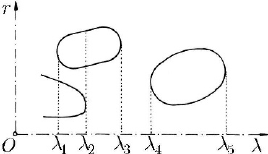
MECHANICAL SYSTEMS, CLASSICAL MODELS
700
the circumference of radius
2
r one has ⋅= = − <rv
22 2
22 22 2 2
cos ( ) 0rv r R rα , hence
cos 0, / 2απαπ<<<, so that the trajectories enter inside the circular annulus.
Hence, the circular annulus is a bounded domain which does not contain critical points
of the system of differential equations, and the trajectories ones entered in this domain,
remain there; according to the Poincarè–Bendixon theorem, the system of differential
equations (23.1.77) admits at least a closed trajectory entirely situated in the interior of
the circular annulus, hence at least a periodic solution of the form
=−=−
12
cos( ), sin( )xR t xR tωϕ ωϕ,
(24.3.4')
as it can be easily shown.
Let be Liénard’s differential equation
++=() 0xfxxx ;
(24.3.5)
one can show that this equation admits a periodic solution if:
(i) the function
()fx is Lipschitz continuous in ;
(ii)
=
∫
0
() ()d
x
Fx fξξ is an odd function;
(iii) there exists a constant
> 0α so that, for <<0 x α , one has <() 0Fx ;
(iv) there exists a constant
> 0β so that, for >x β , >() 0Fx is monotone
increasing and
→∞
=∞lim ( )
x
Fx .
As well, the differential equation
+=() 0xfx
(24.3.6)
admits a periodic solution if
()fx is an odd function of class
0
C , definite in
, which
verifies the condition
>() 0fx for 0, 0x αα<≤ >.
Fig. 24.34 The system of differential equations (24.3.7); the diagram (, ) 0
f
r λ =
Let be the system of differential equations (24.2.1), depending on the real parameter
∈λ ; a study of the equation has been made in Sect. 24.2.1.1, obtaining a statistical
ramification diagram and a certain number of configurations of equilibrium. We notice
that, for certain values of the parameter
λ , it is possible to have not such a motion; in
this case too, one can build up a diagram of ramifications, there appear points of
ramification etc.

Dynamical Systems. Catastrophes and Chaos
701
Let be, e.g., the system of differential equations in polar co-ordinates, in
2
,
===
00
(, ), , constrfrλθ ωω
;
(24.3.7)
the diagram
=(, ) 0frλ which – obviously – corresponds to some circular periodic
motions with the angular velocity
=
0
ωω, can have the form in Fig. 24.34. In this
case, for
5
34
, , λλλλλλ=== there exists a periodic motion, for <
1
λλ,
5
234
, λλλλλλ<< << there exist two periodic motions, for
14
, λλλλ==
there exist three periodic motions, while for
<<
12
λλλ
there exist four periodic
motions; for
<<
34
λλλ and >
5
λλ there do not exist periodic motions.
Sometimes, it is quite difficult to get the number of the periodic solutions.
24.3.1.2 Hopf’s Bifurcation
The local bifurcations govern, in general, the mutation of the configurations of
equilibrium or of the limit cycles. We mention thus Hopf’s bifurcation, which
transforms a configuration of equilibrium into a limit cycle (Marsden, J.E. and
McCracken, M., 1950).
Let be a damped non-linear free oscillator, the motion of which is described by the
differential equation
++ + =
2
(,) 0xkx xfxxω ,
(24.3.8)
where
(,)fxx contains the non-linear terms; the equivalent system of differential
equations is of the form
==−−−
2
122 2 1 12
,(,)xxx kx xfxxω .
(24.3.8')
It is easily seen that to a change of sign of the constant
k , from + to –, the eigenvalues
of the linearized system pierce the imaginary axis at
2
,λλ ω=± −
. Hence, the Hopf
bifurcation can be associated with the vanishing of the linear damping in the motion of
an oscillator.
Let us consider also the Van der Pol equation
()
22
10, 0xx xxαωα+−+=>
,
(24.3.9)
which represents the motion of a non-linear oscillator after a Hopf bifurcation. If
x is
small, then we can neglect the term
2
x
in the bracket, obtaining an oscillation of
increasing amplitude. If
x increases, then the term of linear damping
2
xx becomes
dominant, but the motion must remain bounded. In the phase portrait, the system leads
to a postcritic limit cycle.
One obtains the same conclusion using the term
=
3
()fx x
, which corresponds to
the equation
